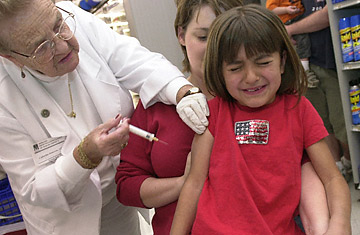
A child receives a flu shot.
Getting a flu shot is an annual rite of passage — or at least, according to U.S. health officials, it should be. For the first time, the Centers for Disease Control and Prevention (CDC) recommends this year that all children aged six months through 18 years receive the flu vaccine; previous advisories included children only up to five years old.
Government data indicate that the flu shot is more necessary than ever. The rate of flu deaths among children, while not high, are continuing to rise — more than 80 deaths were recorded in the 2007-2008 flu season, according to the CDC — highlighting the potential benefit of vaccination.
Yet a new study published Oct. 6 in the Archives of Pediatrics & Adolescent Medicine suggests otherwise — that the flu shot in children doesn't necessarily protect them from illness. Led by Dr. Peter Szilagyi, researchers at University of Rochester studied 414 children aged 5 and younger, who came down with the flu during the 2003-2004 or 2004-2005 flu seasons. These children were compared with over 5,000 controls who did not have influenza during the same seasons. Turns out that flu shots seemed not to make much difference: Kids who got immunized did not get the flu at lower rates than unvaccinated kids. In fact, the immunized youngsters were just as likely to be hospitalized or to visit the doctor as kids who never received the vaccine.
But before you decide to skip the flu shot this year, experts warn that results of flu studies like this are all about design. Depending on how a particular trial is set up — which populations are studied, which vaccine is used and how many subjects are included — the results can vary, and quite significantly. The Rochester study, for example, happened to look at the effectiveness of a vaccine during two seasons in which the flu strain included in the vaccine was not well matched to the predominant circulating strain that was making people sick. That could explain the lack of protection among the vaccinees — the shot may have been protecting against the wrong flu proteins. Targeting the correct strain is a always a bit of a guessing game, however; researchers make their best scientifically based prediction as to which flu virus will be making the rounds in a coming season, but they often have to make these predictions up to nine months ahead of time, in order to keep up with the lengthy vaccine manufacturing process. "In some circumstances, it is like forecasting the weather," says Dr. Geoffrey Weinberg, professor of pediatrics at University of Rochester. "Sometimes we are right on, and sometimes we are off."
Another reason for the flu shot's failure may have been the fact that certain forms of the vaccine are more effective than others in children. In this study, most of the children received the injected vaccine, but recent studies have shown that the nasal spray, known as FluMist, appears to be better at protecting youngsters from influenza (offering about the same level of protection as the injected vaccine in adults). In kids, says Dr. William Schaffner of Vanderbilt University School of Medicine and an advisory member of the CDC's Advisory Committee on Immunization Practices, the nasal spray may help the immune system launch a broader and more diverse immune defense, since the vaccine contains weakened forms of live flu virus that replicate rapidly in the mucosal tissues. Such furiously multiplying viruses may actually benefit vaccine effectiveness in flu seasons like those included in the study, when there is significant mismatch — or "drift" — between the circulating flu strains and the vaccine strains, because the faster the viruses divide, the more likely they are to develop more mutations, some of which may actually end up matching those circulating in the community.
Finally, notes Weinberg, who was not involved in the new study but is familiar with its design and results, the lack of effectiveness could have been due in part to the trial's small sample size. "The bigger numbers you have, the better," he says. "Five hundred subjects may sound like a lot, but once you start stratifying them by age, by whether they received all of their shots, or which year they were immunized, your total number gets smaller."
All of which means that, as this study's results show, we need to become more realistic when it comes to our expectations of the annual flu shot. There is no guarantee that it will work, but on a population level, odds are that it's better to get a flu shot than not. "We all recognize that the influenza vaccine is not as effective as the polio vaccine, or the measles vaccine," says Schaffner. "It's not a great vaccine, but it is quite a good vaccine. We are not going to eliminate influenza through the use of this vaccine. But we can mitigate its devastating impact on the population if we get immunized."
